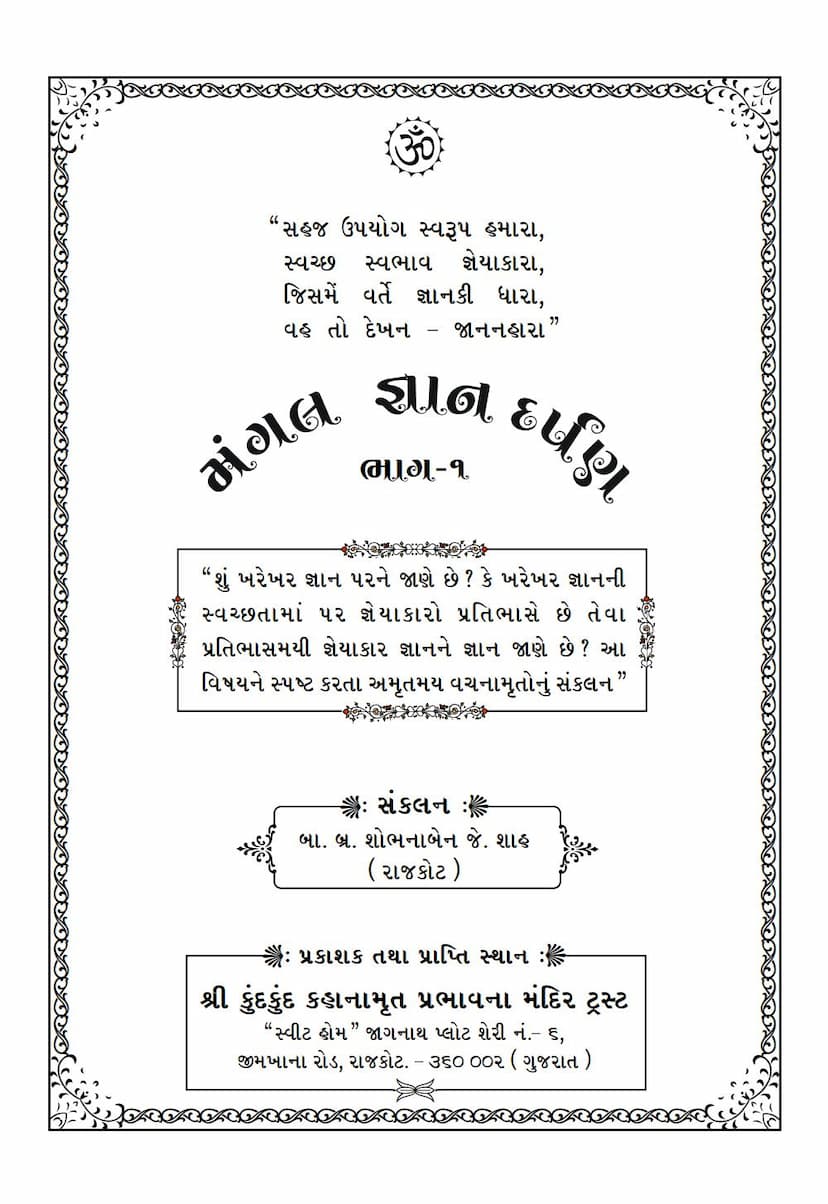Mangal Gyan Darpan Part 1
Added to library: September 2, 2025

Summary
The provided Jain text, "Mangal Gyan Darpan Part 1" by Shobhnaben J Shah, is a profound exploration of Jain philosophy, particularly focusing on the nature of knowledge and the path to liberation. The book, published by Shree Digambar Jain Kundamrut Kahan, delves into complex metaphysical concepts, emphasizing the self-illuminating and all-pervasive nature of the soul's knowledge.
Key Themes and Concepts:
- The Nature of Knowledge (Gyan): The text extensively discusses the concept of swayam-prakashak (self-illuminating) and swapar-prakashak (self and other illuminating) knowledge. It distinguishes between knowing the self (swa) and knowing the external (para). The core idea is that true knowledge originates from within the soul, and the external world is perceived through the clarity and purity of this inner knowledge. The text emphasizes that the soul's knowledge is not passive but an active process of self-realization, where the external is known without being affected by it.
- Self-Reliance and Inner Experience: A recurring theme is the importance of introspection and self-reliance. The book guides the reader towards turning their attention inward to realize the inherent omniscient nature of the soul. External rituals or dependencies are downplayed in favor of cultivating internal awareness and experience.
- Distinguishing the Self from the Non-Self: A significant portion of the text is dedicated to clarifying the difference between the soul (jiva) and non-soul elements (ajiva), such as matter, actions (karma), and external objects (para). It stresses that attachment to these external elements (para) leads to ignorance and bondage, while detachment and focus on the soul's true nature lead to liberation. The concept of vichar (reflection) and vivek (discernment) is highlighted as crucial for distinguishing the eternal self from the transient external.
- The Fourfold Path: The text implicitly or explicitly refers to the Jain path to liberation, which involves right faith (samyak darshan), right knowledge (samyak jnana), and right conduct (samyak charitra). The importance of bhed-jnana (discriminative knowledge) is repeatedly emphasized as the key to understanding the true nature of reality and achieving liberation.
- The Role of "Pratibhas" (Manifestation/Apprehension): The term pratibhas is frequently used to describe how knowledge manifests. The text explores the subtle distinction between pratibhas (apprehension of something) and true jnana (knowledge). It clarifies that while knowledge might apprehend both the self and the external, the ultimate goal is to focus the consciousness on the self (swa) for true liberation.
- Analogy of the Mirror: The mirror analogy is used to illustrate the nature of knowledge. Just as a mirror reflects objects without being affected by them, the soul's knowledge can apprehend the external world without being stained by it. The purity of the mirror is analogous to the purity of the soul's consciousness.
- The Significance of Naya (Viewpoints): The text touches upon the Jain concept of naya, which acknowledges different perspectives on reality. It highlights the importance of understanding the distinction between nishchaya-naya (ultimate truth/essential reality) and vyavahar-naya (conventional truth/practical reality) to grasp the full picture of spiritual practice.
- Spiritual Progress: The book seems to guide the reader through spiritual progress, from initial understanding to experiencing the self-realized state. The emphasis on purushartha (effort) and sustained spiritual practice is evident.
- The Teachings of Acharya Kundakunda and Acharya Kanji Swami: The text heavily draws upon the teachings of prominent Jain scholars, particularly Acharya Kundakunda (for his works like Samaysara) and the modern exponent Acharya Kanji Swami. The compiler, Shobhnaben J Shah, and the publisher, Shri Digambar Jain Kund Kund Kahanamrut Prabhavna Mandir Trust, are credited for bringing these profound teachings to light.
Summary of Key Sections (Based on the provided text snippets):
The introductory verses and publisher's notes set the stage, highlighting the book's purpose: to clarify complex philosophical concepts through the compilation of "nectar-like words" that illuminate the nature of knowledge, particularly the self-illuminating and swapar-prakashak qualities.
The compiler, Shobhnaben J Shah, is praised for her dedicated effort in compiling this work, which aims to dispel mithyatva (false beliefs) and lead to true self-realization.
The text emphasizes that the soul's true nature is knowledge itself. The challenge lies in directing this knowledge towards the self rather than getting lost in external perceptions. It delves into the four points of spiritual practice, emphasizing the soul's inherent nature, the manifestation of self and other, and the crucial role of the fourth point—the soul's effort—in determining the path of bondage or liberation.
A central discussion revolves around the term "swapar-prakashak" (self and other illuminating) and its nuanced meaning in Jainism. The text explains that while knowledge inherently reflects both the self and the external, the crucial aspect is the direction of attention (lakshya). Focusing on the self leads to liberation, while lingering on the external leads to bondage.
The book explores the subtlety of dravya (substance) and paryaya (modes/manifestations) in Jain metaphysics. It clarifies that while the substance of the soul remains eternal and unchanging, its momentary manifestations (paryaya) interact with external causes. Understanding this distinction is vital for correct spiritual practice.
The text also highlights the importance of bhed-jnana (discriminative knowledge) in differentiating the self from non-self and in progressing on the spiritual path. It critiques the tendency to mistake the reflection of reality (perceived through knowledge) for the reality itself, emphasizing the need to go beyond mere apprehension to true experience (anubhava).
The compilation includes references to various sacred texts and teachings, emphasizing the wisdom passed down through generations of Jain acharyas. It aims to provide a clear and accessible explanation of these profound spiritual truths for the benefit of all seekers.
Overall Purpose:
"Mangal Gyan Darpan Part 1" serves as a spiritual guide, aiming to illuminate the Jain path to self-knowledge and liberation. It emphasizes the inherent divinity of the soul and the power of self-reflection and right perspective (samyak darshan) in achieving spiritual freedom. The text encourages a deep understanding of Jain philosophy, particularly the nature of consciousness and its interaction with the world, to overcome ignorance and attain ultimate bliss.